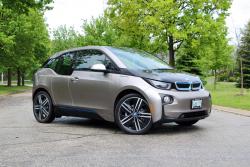 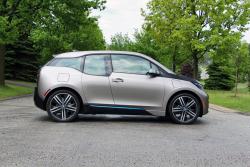 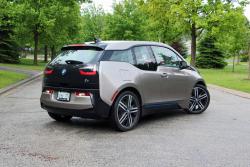 2014 BMW i3. Click image to enlarge |
Review and photos by Jonathan Yarkony
The i3 has landed.
Although it’s small, a little bit goofy looking (okay, a lot goofy looking), and unlikely to sell more than a handful, the BMW i3 is a bit of a big deal. BMW’s electric program has been seven years in the making, and in that time their research has shown consumer attitudes changing from critical to curious. The people are ready.
It’s been a while since any established, full-line manufacturer has launched a dedicated electric vehicle line, and BMW is jumping in with both feet. The i3 is the practical city runabout, and the i8 sports car will follow soon after. Though they look incredibly different, they both follow the same design aesthetic and guiding philosophies. And although the i8 is dead sexy, it is the i3 that took home the World Car Design of the Year Award, the jury taking particular note of its “radical leap in interior design” and its strong BMW brand identity but with a character all its own.
BMW is completely invested in electric mobility and what started with fanciful concepts has been shaped by over 21,000,000 km of real-world testing data with limited-run models like the Mini E and BMW ActiveE. BMW has also wisely invested in their own carbon-fibre research and production capacity, which has not only paved the way for weight and performance advantages in their electric program, but also transfer over to their performance and luxury vehicles.
The BMW i3 is based on a two-part structure: the drive module and the passenger cell. The lightweight CFRP (carbon-fibre-reinforced plastic) passenger cell is bonded and screwed to the drive module, which houses the battery, electric motor and, where applicable, the combustion engine. With such highly segmented structures, it will be incredibly easy to design different body types around the underlying architecture. Renderings of a mid-sized wagon vehicle type have already surfaced.
The i3 is a four door hatchback, with an extremely roomy front seat and a tight back seat that is easy to access thanks to reverse-opening rear doors. The trunk is small, comparable to smaller subcompacts. Exterior dimensions are similar to the Honda Fit or Nissan Verssa Note, though shorter in length, taller and a bit wider. Turning radius is better than either of those at about 5.0 m, a strong asset in a city car. With a standard back-up camera, this is one easy car to park.
No matter the cabin attached, the vehicle should maintain the near 50:50 weight distribution and low centre of gravity facilitated by the heavy batteries encased under the vehicle floor, aluminum platform and extremely light yet rigid cabin structure. In this case, the i3 weighs in at 1,297 kg (1,420 kg for the range-extended version) and promises comparable or superior crashworthiness properties, though it has yet to complete its North American crash testing regimen.
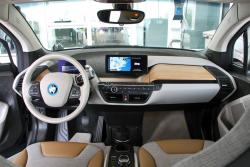 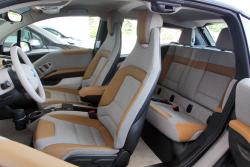 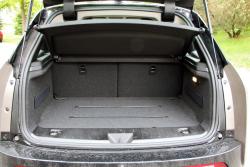 2014 BMW i3 dashboard, seating, cargo area. Click image to enlarge |
As with any electric vehicle, the biggest question is range. The i3 is estimated at 160 km of electric range courtesy of a 18.8 kWh lithium-ion battery. A level 2 charging unit will ‘fill it up’ overnight, while normal household outlet power would give you enough power (80 percent from standard household outlet in about 8 hours) to get safely to and from work for your average urban commute (BMW data suggests average daily round trip is 47 km). Full charge from empty using a standard household outlet would take about 20 hours, but as little as 3.5 hours using the level 2 charger.
The electric motor is good for 170 hp and 184 lb-ft of torque, and the little things zip along with plenty of zap. BMW pegs acceleration at 7.2 seconds to 100 km/h, but it is the 0–40 that is truly rewarding (about 3.7 seconds to 60 kph), the instantaneous torque offering a surge off the line that would make for excellent in-city scooting.
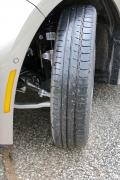 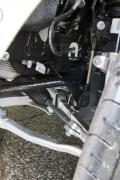 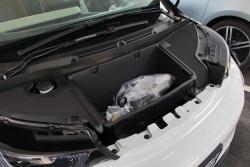 2014 BMW i3 wheel, axle detail, front storage area with charging cable, steering wheel shifter. Click image to enlarge |
Handling is downright shocking. You look at its tall, ungainly proportions and think it is going to lean like an old Citroën, but with all its weight under your feet, there is surprisingly little body roll (though we did not drive particularly aggressively) and there is surprising grip from the tall, skinny tires (as equipped we sampled the 20-inch wheel option with 155/60R20 rubber in front and 175/55R20 in back – note how awkwardly skinny they look in pictures). No doubt the ride is a tad firm, but the CFRP structure is solid and the front MacPherson and rear five-link suspension does an amazing job of maintaining grip and alleviating excessive impact shock from affecting the cabin and its occupants.
However, between the light weight, easy access to torque, low centre of gravity and quick steering response but hefty steering weight, the car is a joy to pilot. Approach a corner and it requires a bit of elbow to get the wheel moving, but the car translates input precisely and turns in sharply, so tight turns and lane changes are simple joys to be found in every drive, much like BMW’s other city car, the Mini, though not to that degree.














